instrument panel Oldsmobile Aurora 1997 Owner's Manuals
[x] Cancel search | Manufacturer: OLDSMOBILE, Model Year: 1997, Model line: Aurora, Model: Oldsmobile Aurora 1997Pages: 404, PDF Size: 20.75 MB
Page 17 of 404
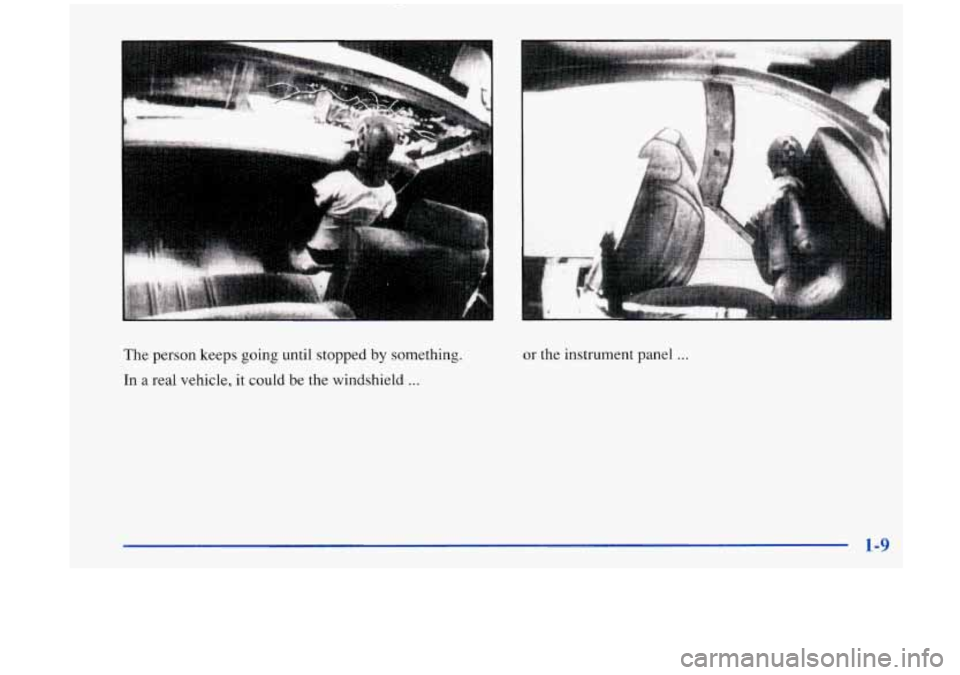
The person keeps going until stopped by something.
In
a real vehicle, it could be the windshield ...
or the instrument panel ...
Page 28 of 404

A CAUTION:
Air bags inflate with great force, faster than the blink of an eye.
If you’re too close to an inflating
air
bag, it could seriously injure you. Safety belts
help keep you in position before and during
a
crash. Always wear your safety belt, even with air
bags. The driver should sit as
far back as possible
while still maintaining control of the vehicle.
A CAUTION:
I-
An inflating air bag can seriously injure small
children. Always secure children properly in your
vehicle.
To read how, see the part of this manual
called “Children” and the caution label on the
right front passenger’s safety belt.
AIR BAG
There is an air bag
readiness light on the
instrument panel, which
shows
AIR BAG.
The system checks the air bag electrical system
for
malfunctions. The light tells you if there is an electrical
problem. See
“Air Bag Readiness Light” in the Index
for more information.
1-20
Page 29 of 404
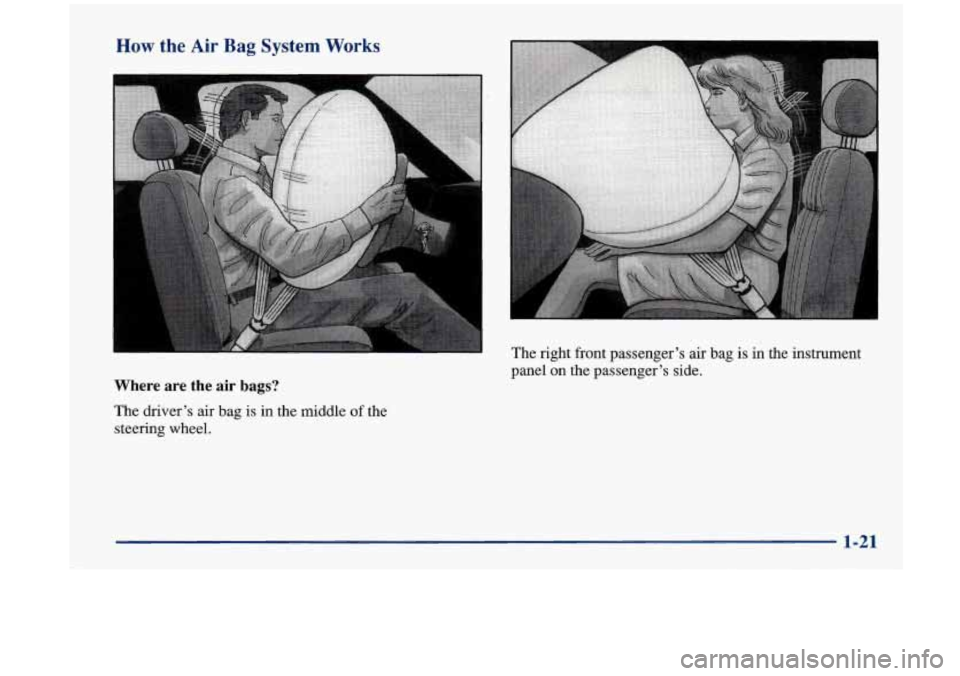
How the Air Bag System Works
Where are the air bags?
The driver’s air bag is in the middle of the
steering wheel.
I
The right front passenger’s air bag is in the instrument
panel on the passenger’s side.
1-21
Page 31 of 404
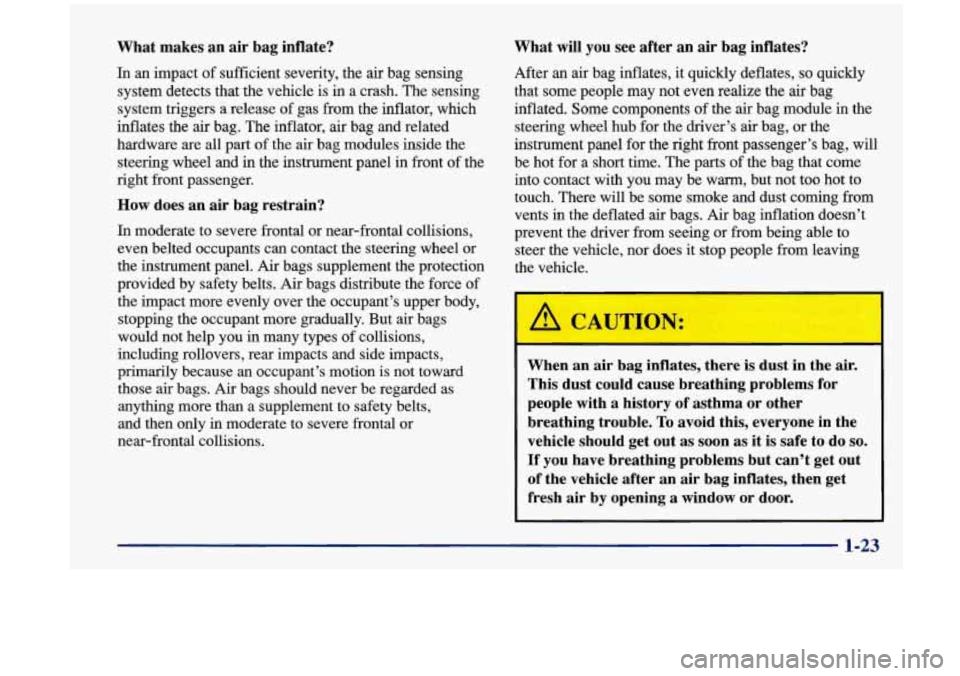
What makes an air bag inflate?
In an impact of sufficient severity, the air bag sensing
system detects that the vehicle is
in a crash. The sensing
system triggers a release of gas from the inflator, which
inflates the air bag. The inflator, air bag and related
hardware are all part of the air bag modules inside the
steering wheel and in the instrument panel in front of the
right front passenger.
How does an air bag restrain?
In moderate to severe frontal or near-frontal collisions,
even belted occupants can contact the steering wheel or
the instrument panel. Air bags supplement the protection
provided by safety belts.
Air bags distribute the force of
the impact more evenly over the occupant’s upper body,
stopping the occupant more gradually. But air bags
would not help you in many types of collisions,
including rollovers, rear impacts and side impacts,
primarily because
an occupant’s motion is not toward
those
air bags. Air bags should never be regarded as
anything more than a supplement to safety belts,
and then only
in moderate to severe frontal or
near-frontal collisions.
What will you see after an air bag inflates?
After an air bag inflates, it quickly deflates, so quickly
that some people may not even realize the air bag inflated. Some components of the air bag module in the
steering wheel hub for the driver’s
air bag, or the
instrument panel
for the right front passenger’s bag, will
be hot for
a short time. The parts of the bag that come
into contact with you may be warm, but not too hot to
touch. There will be some smoke and dust coming from
vents in the deflated
air bags. Air bag inflation doesn’t
prevent the driver from seeing or from being able to steer the vehicle, nor does it stop people from leaving
the vehicle.
When an air bag inflates, there is dust in the air.
This dust could cause breathing problems for
people with a history of asthma or other
breathing trouble. To avoid this, everyone in the
vehicle should get
out as soon as it is safe to do so.
If you have breathing problems but can’t get out
of the vehicle after an air bag inflates, then get
fresh air by opening a window or door.
1-23
Page 32 of 404

In many crashes severe enough to inflate an air bag,
windshields are broken
by vehicle deformation.
Additional windshield breakage may
also occur from the
right front passenger air bag.
Air bags are designed to inflate only once. After they
inflate, you’ll need some new parts for your air bag
system. If you don’t get them, the air bag system
won’t be there to help protect you in another crash.
A new system will include air bag modules and
possibly other parts. The service manual for your
vehicle covers the need
to replace other parts.
Your vehicle is equipped with a crash sensing and
diagnostic module, which records information about
the
air bag system. The module records information
about
the readiness of the system, when the sensors are
activated and driver’s safety belt usage at deployment.
Let only qualified technicians work on your air bag
system, Improper service can mean that your air
bag system won’t work properly. See your retailer
for service.
NOTICE:
If you damage the covering for the driver’s or the
right front passenger’s air bag, the bag may not
work properly. You may have to replace the air
bag module
in the steering wheel or both the air
bag module and the instrument panel for the
right front passenger’s air bag.
Do not open or
break the air bag coverings.
Page 57 of 404
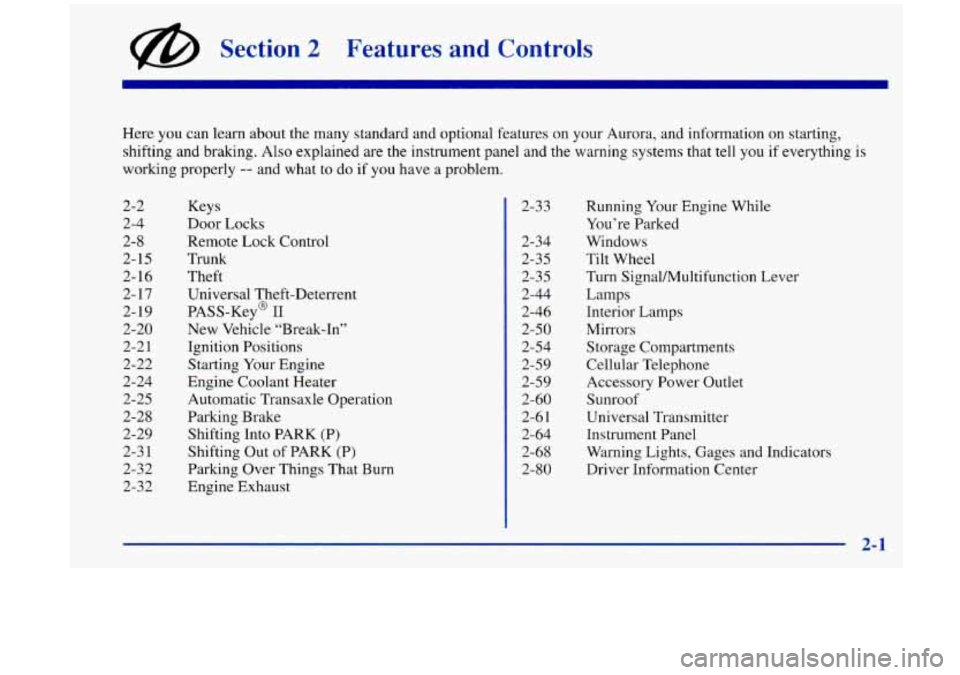
@ Section 2 Features and Controls
2-2
2-4 2-8
2- 15
2-16
2- 17
2- 19
2-20
2-2 1
2-22
2-24
2-25
2-28
2-29
2-3 1
2-32
2-32 2-3
3
2-34
2-3
5
2-35
2-44
2-46
2-50
2-54
2-59
2-59
2-60
2-6
1
2-64
2-68 2-80
Here
you can learn about the many standard and optional features on your Aurora, and information on starting,
shifting and braking. Also explained
are the instrument panel and the warning systems that tell you if everything is
working properly -- and what to do if you have a problem.
Keys
Door Locks
Remote Lock Control
Trunk
Theft
Universal Theft-Deterrent
PASS-Key@
I1
New Vehicle “Break-In”
Ignition Positions
Starting Your Engine
Engine Coolant Heater Automatic Transaxle Operation
Parking Brake Shifting Into PARK
(P)
Shifting Out of PARK (P)
Parking Over Things That Burn
Engine Exhaust Running
Your Engine While
You’re Parked
Windows Tilt Wheel
Turn SignaUMultifunction Lever Lamps
Interior Lamps
Mirrors Storage Compartments
Cellular Telephone
Accessory Power Outlet Sunroof
Universal Transmitter
Instrument Panel
Warning Lights, Gages and Indicators
Driver Information Center
2-1
Page 72 of 404
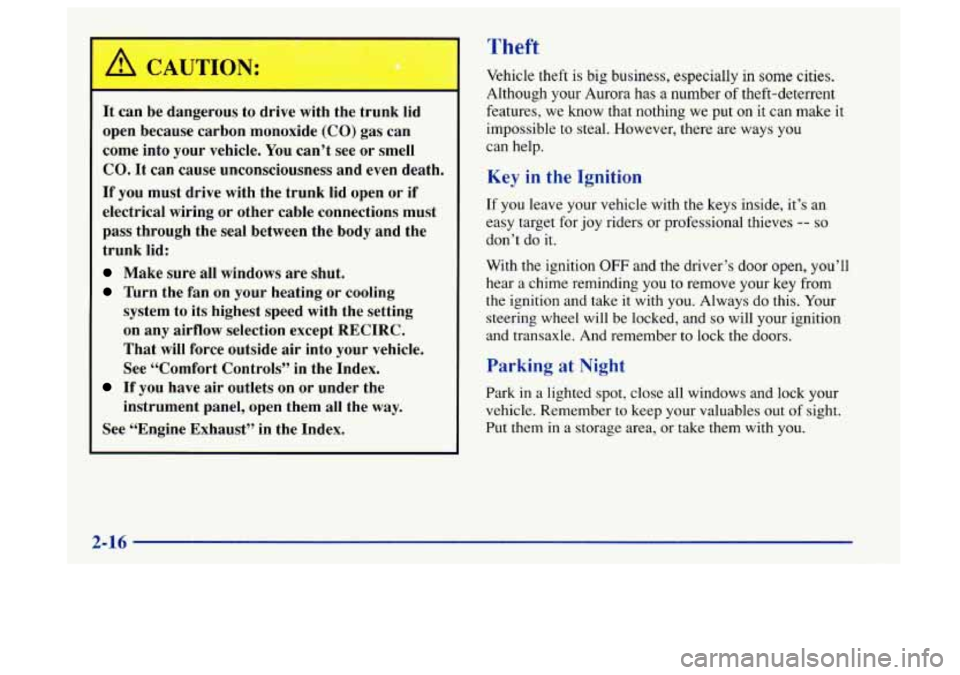
It can be dangerous to drive with the trunk lid
open because carbon monoxide (CO)
gas can
come into your vehicle.
You can’t see or smell
CO. It can cause unconsciousness and even death.
If you must drive with the trunk lid open or if
electrical wiring or other cable connections must
pass through the seal between the body and the
trunk lid:
Make sure all windows are shut.
Turn the fan on your heating or cooling
system to its highest speed with the setting
on any airflow selection except RECIRC.
That will force outside air into your vehicle.
See “Comfort Controls” in the Index.
If you have air outlets on or under the
instrument panel, open them
all the way.
See “Engine Exhaust” in the Index.
Theft
Vehicle theft is big business, especially in some cities.
Although your Aurora has a number of theft-deterrent
features, we know that nothing we put on
it can make it
impossible
to steal. However, there are ways you
can help.
Key in the Ignition
If you leave your vehicle with the keys inside, it’s an
easy target for joy riders or professional thieves
-- so
don’t do it.
With the ignition
OFF and the driver’s door open, you’ll
hear a chime reminding you to remove your key from
the ignition and take it with you. Always do this. Your
steering wheel will be locked, and
so will your ignition
and transaxle. And remember
to lock the doors.
Parking at Night
Park in a lighted spot, close all windows and lock your
vehicle. Remember to keep your valuables out
of sight.
Put them in a storage area, or take them with you.
2-16
Page 77 of 404
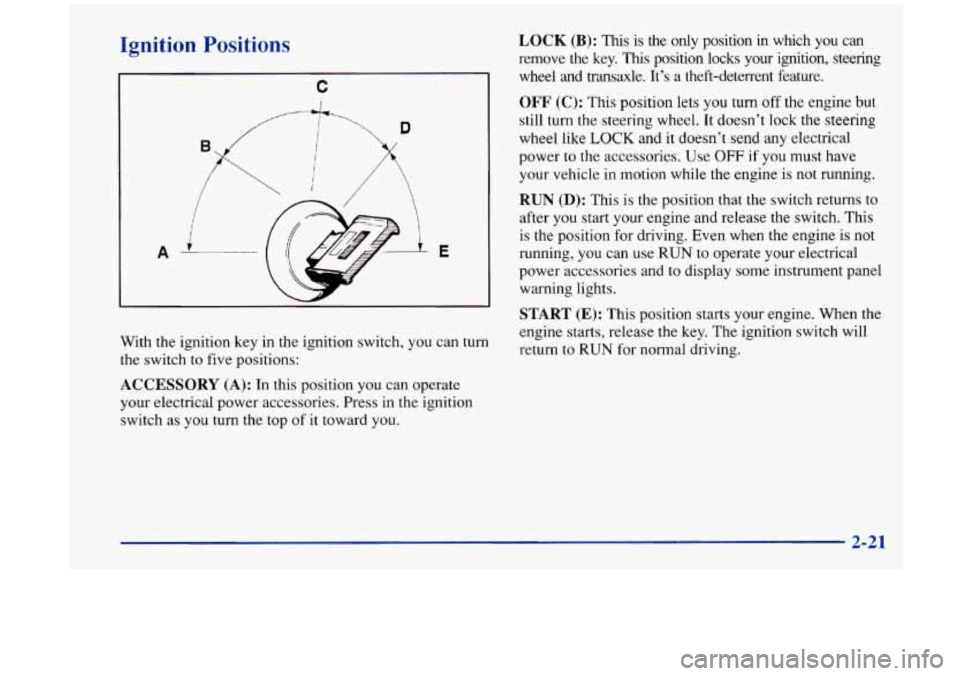
Ignition Positions
C
D
1 I
A E
With the ignition key in the ignition switch, you can turn
the switch to five positions:
LOCK (B): This is the only position in which you can
remove the key. This position locks your ignition, steering
wheel and transaxle. It’s a theft-deterrent feature.
OFF (C): This position lets you turn off the engine but
still turn the steering wheel. It doesn’t lock the steering
wheel like
LOCK and it doesn’t send any electrical
power to the accessories. Use
OFF if you must have
your vehicle in motion while the engine is not running.
RUN (D): This is the position that the switch returns to
after you start your engine and release the switch. This
is the position for driving. Even when the engine
is not
running, you can use
RUN to operate your electrical
power accessories and to display some instrument panel
warning lights.
START (E): This position starts your engine. When the
engine starts, release the key. The ignition switch will
return to
RUN for normal driving.
ACCESSORY (A): In this position you can operate
your electrical power accessories. Press in the ignition
switch as you turn the top of it toward you.
2-21
Page 92 of 404
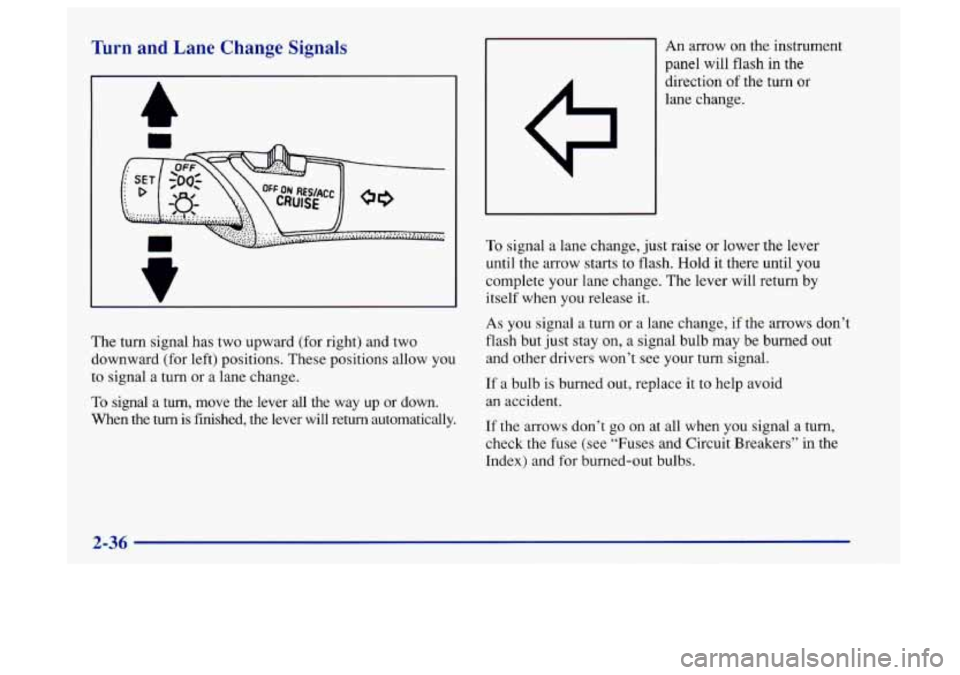
Turn and Lane Change Signals
n
The turn signal has two upward (for right) and two
downward (for left) positions. These positions allow you
to signal a turn or a lane change.
To signal a tum, move the lever all the way up or down.
When the
turn is finished, the lever will return automatically. An
arrow
on the instrument
panel will
flash in the
direction of the turn or
lane change.
To signal a lane change, just raise or lower the lever
until the arrow starts to flash. Hold it there until you
complete your lane change. The lever will return
by
itself when you release it.
As you signal a turn or a lane change, if the arrows don’t
flash but just stay
on, a signal bulb may be burned out
and other drivers won’t see your turn signal.
If a bulb is burned out, replace it to help avoid
an accident.
If the arrows don’t go on at all when you signal a turn,
check the fuse (see “Fuses and Circuit Breakers” in the
Index) and for burned-out bulbs.
2-36
Page 93 of 404
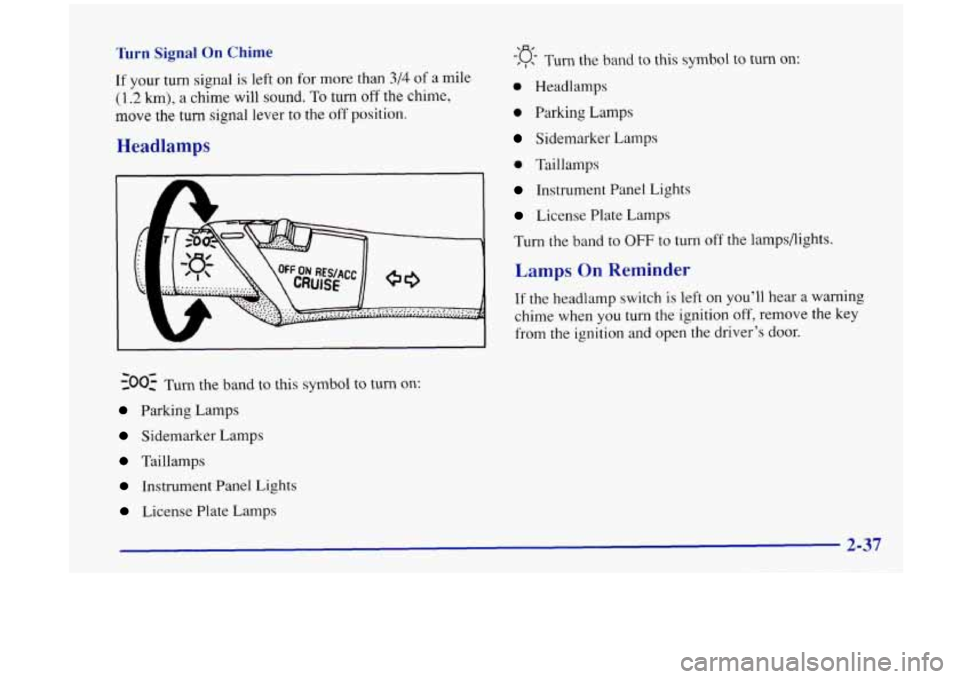
Turn Signal On Chime
If your turn signal is left on for more than 3/4 of a mile
(1.2 km), a chime will sound. To turn off the chime,
move the turn signal lever to the off position.
Headlamps
Turn the band to this symbol to turn on:
Parking Lamps
Sidemarker Lamps
Taillamps
Instrument Panel Lights
License Plate Lamps
-‘Q , , Turn the band to this symbol to turn on:
0 Headlamps
0 Parking Lamps
Sidemarker Lamps
0 Taillamps
Instrument Panel Lights
License Plate Lamps
Turn the band to
OFF to turn off the lampsflights.
Lamps On Reminder
If the headlamp switch is left on you’ll hear a warning
chime when you turn the ignition
off, remove the key
from the ignition and open the driver’s door.